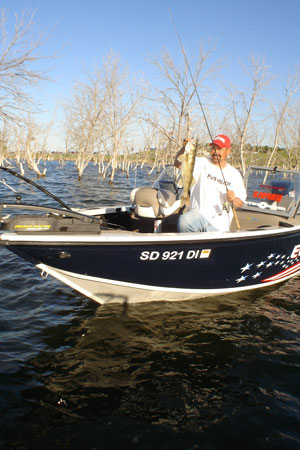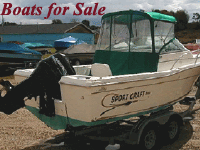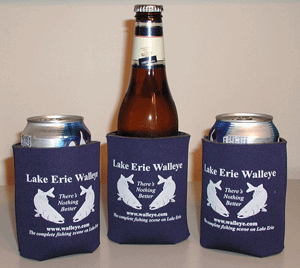With the arrival of the fall come some big changes. As the cooling
effects
 of
fall begin to change a walleyes environment the result can have a
definite effect on where they can be found and just how active they’ll
be. They say that a little change can be a good thing, and if so the
early fall period is no exception.
of
fall begin to change a walleyes environment the result can have a
definite effect on where they can be found and just how active they’ll
be. They say that a little change can be a good thing, and if so the
early fall period is no exception.
Late summer can make for some tough conditions and walleyes can play
a little hard to get. Where they went and what they did really doesn’t
matter now. Now is when walleyes start to show themselves again, and
they do it with a new and much more agreeable attitude.
That new attitude is a result of cooler water temps and an
instinctive response that pushes ol’ marble eyes into a serious feeding
binge which can last right through the fall and into the early ice
period. Taking advantage of the situation is what it’s all about and
requires a little understanding of a walleye’s basic needs and a handful
of baits to get in on the action.
Where they begin to show up doesn’t always fit into the category of
“classic” fall structure, and might be more associated with early season
locations. Shallow flats or even back bays could heat up with the fall
cool down. Cooling water temps can bring walleyes up shallow and spur
activity that can be downright intense at times. On reservoirs it might
be up major creek arms where immature white bass and perch have been
holding out and growing up but now have to move out with the fall draw
down. Walleyes will wait and ambush all of that prey is it makes it’s
way to the main channel. On natural lakes it could be weedy flats, or
maybe rocky bars or reefs. It will all depend on what‘s available but
you can usually find a shallow water pattern somewhere early in the
fall. Late fall is another story and when “classic” really comes into
the picture but this is now, and there’s plenty of good reasons to get
back on the water.
If you’re working a reservoir look for bridges that are up creek arms
as they are usually associated with necked down areas and can serve as
funnels that will help to concentrate fish. The fall draw down creates
current which is increased by areas that are pinched off, or necked
down. The result is a funnel effect where walleyes can wait and ambush
bait that is delivered directly to them on a silver platter. Walleyes
instinctively know that current areas can provide some tremendous
feeding opportunities, and are drawn to them like a magnet. Any bridge
should be checked out but one surrounded by deeper water has the most
potential to be a serious producer. A bridge up a creek arm with some
fifteen to twenty feet of water nearby would fall into the “serious
producer” category.
Top presentations for bridge bound walleyes include dragging bottom
bouncer and live bait combinations, casting with a jig tipped with a
minnow or crawler, or vertical jigging depending on how deep and how
clear the water is that you happen to be working. Casting crankbaits
like a Glass Shad Rap is another option, and can be especially effective
if you have some darker water up shallow. The Glass Shad Rap is perfect
for casting as it’s heavy enough, will suspend , and has built in
rattles.
Rocky bars and reefs might be more suited for a trolling run and will
depend on just how big an area you have to deal. A big expansive rocky
bar or reef is custom made for a crank bait trolled just over the tops
of the rocks and will allow you to cover some ground. Smaller spots
might be more effectively worked with a casting technique which will
allow you to pinpoint the most productive areas.
Weed beds can be trolled with a crank bait, cast to with a crank or
jig, or trolled with a jig. It will all depend on the makeup of the weed
bed and how much water you to cover. A sparse weed bed is perfect for
trolling a jig right through the middle of the stuff. The thicker beds
may push you out to the deep edge or keep you working over the top. A
hot late summer and early fall pattern includes running lipless cranks
like the Rattle Rap across the tops of cabbage and coontail weed beds.
Water clarity is another consideration which can have an effect on
when the walleyes can be expected to be the most active. Darker water
will help promote daytime activity while clear conditions may force you
to try burning the midnight oil. Wind can have an effect on clear water
and could really stir things up, especially if it howls out of the same
direction for a couple of days or more. High winds and heavy waves can
stir up bottom sediment and turn clear conditions to stained and trigger
intensive daytime activity. It’s something to be aware of and can create
a terrific opportunity for some serious pole bending.






 of
fall begin to change a walleyes environment the result can have a
definite effect on where they can be found and just how active they’ll
be. They say that a little change can be a good thing, and if so the
early fall period is no exception.
of
fall begin to change a walleyes environment the result can have a
definite effect on where they can be found and just how active they’ll
be. They say that a little change can be a good thing, and if so the
early fall period is no exception.